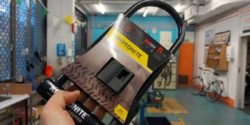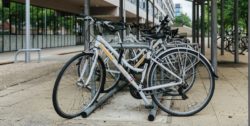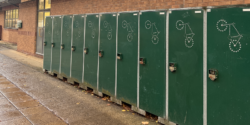Keeping your bike safe in Leeds
Leeds is generally a safe place to live, study and work, and cycling is a great way to get around. But as in any major city, bicycles can be a target for thieves.
Losing your treasured wheels can be upsetting and expensive. So, what can you do to help keep your bike safe?
Our top tip - a decent lock!
If you only do one thing, buy and use a ‘sold secure’ D-Lock to secure your bike to something solid – preferably a bike rack! No lock is foolproof, but chain and cable locks can typically be cut through by thieves in seconds and do little to protect your ride.
Discounted ‘sold secure’ D-locks are available to purchase at the Bike Hub near the Roger Stevens building on campus, or at the Security Services office at 175 Woodhouse Lane (a short walk from Laidlaw Library).

Here’s some more tips on protecting your bike:
Before you leave home:
- Insure your bike – either with specific cycle insurance or as a listed item under your existing home/contents insurance cover.
- Register your bike with the BikeRegister, the UK’s national bicycle marking and registration scheme. This adds your bike details to the national Police-approved database, alongside security markings. Registering your bike can discourage theft and improve the chances of your bike being returned if it does get stolen. Contact Security Services to register your bike free of charge.
- Take a note of your bike’s serial number – usually found under the bottom bracket – and have a photo of your bike should you need to report it stolen.
- If your bike has quick release wheels, consider an additional cable or security skewers to secure these.
- At home or in Halls of Residences, use internal storage, such as a garage, basement or secure shelter. Make sure you lock your bike to something unmoveable within this space.

When out and about:
- Use a good quality D-lock with a ‘sold secure’ silver or gold rating.
- Lock your bike to something solid and secure, ideally a bike rack, making sure the lock itself goes around the bike frame.
- Always lock your bike in a well-lit, busy area – use our map of cycle racks on campus to find options that might suit you, but also consider how busy the area is at the times you plan to use it.
- Don’t leave removable items such as lights, saddle bags or panniers on your bike when you leave it.
Enclosed Bike Shelters

The University have a selection of enclosed bike shelters on campus. These are accessed using a fob or card, for which a deposit is payable.
Here’s our tips for using an enclosed bike shelter:
- Always lock your bike to a rack inside the shelter using a ‘sold secure’ D-lock.
- Remember to lock the door or gate after you and be aware of anyone trying to ‘tailgate’ to gain access or acting suspicious.
- Always keep your fob or key safe and don’t allow anyone else to use it.
- If you lose your fob or key, contact Security Services immediately so that it can be deactivated.
What do to if things go wrong
If you notice anything suspicious on campus or University property including Halls of Residences, then contact Security Services or report it on the SafeZone app.
And if you witness a crime, or are unlucky enough to be a victim of crime, report it both to the police and the University’s Security Services.
Safe cycling!
Keep up to date on the latest news
- Follow us on Twitter: @UoL_Sus
- Follow us on Instagram: @uol_sus
- Follow us on Facebook: @UoLSustainability
- Sign up to our Sustainability newsletter
United Nations Sustainable Development Goals
We use the United Nations Sustainable Development Goals (SDGs) as a framework to guide our activity. Our Active Travel work links to the following SDGs:
-
- Goal 3: Good health and wellbeing
- Goal 11: Sustainable cities and communities
- Goal 13: Climate action

